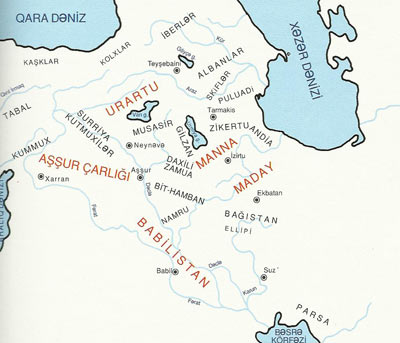Home page
» HISTORY
» States of Azerbaijan
» Minor Asia (I half of I millennium BC)
Minor Asia (I half of I millennium BC) At the end of the second millennium BC, early of first millennium some small beyhoods appeared in Zagros mountains. Among them were Gilzan, Zamua, Allabria, Karalla, Bushtu, Messi, Surikas, Qızılbunda, Alateya, Uisdish, Zikeratu, Andia, Subi, Sanqibutu, Puluadi and others. However, the most powerful among them was Zamua. Although Assyrians very often broke the borders of the Gilzan state, this state continued existence for some period. Urartu captured Gilzan at the end of the IX century BC. Zamua could expend its lands from Lake Urmia to Lesser Zab River. After Kimmers the star of saks shined. They established own power in Minor Asia and the Transcaucasian in VII century BC. Herodotus called them in his work as Scythians. The name of saks was first mentioned in Assyrian sources. Their name was mentioned in one document belonging to period of Assyrian emperor Asarhaddon (680-668 BC). Some historians mention saks as Persian origin, being biased, but saks’ culture, state structure, the structure of the army and horse based army structure and better performing of Bozgir Military Tactics, and words found in Susda documents in the cuneiform writing where words from Turkic languages were used and still used, all it proves that they are of Turkish origin. Events happened Darius during attack on saks are the best arguments. Assyrian sources mentioned them as Ishquz. Saks kept their power till the II century. They could establish a great Empire stretched from the Great Wall of China in east till the river Danube in the west. Ancient Roman historian Strabon wrote: The people lived in the East called massagets and saks. Others were mentioned with the name of ishquz. At the same time, each generation has its own name. In the past, the history books as a whole claimed that Isquzs were Iranian speaking and of Aryan descent. However, historians lived in the I century like Pomponi, Mela and Pliniyon mentioned isguzs as Turkic peoples. Zozima lived in V century also wrote that some isquzs were called as Huns. Although there are no other sources confirming that Massagets were the Turkic-speaking people but some say that they are of Mongolian tribes. But at the same time, it would be wrong to think that ishguz were totally Turkic speaking. Byzantine historian Menanoli lived in the VI century wrote: In the past, the Turks were called as Sak. But A.N.Bernstam noted that: The main source of the Turkish ethnogeny was especially Huns. Both Asian and European Huns caused formation of ishquzs.” At that time, the political organizations formed in the southern territory of modern Azerbaijan are not found in the north.
|
